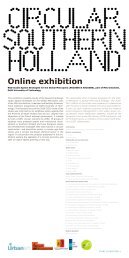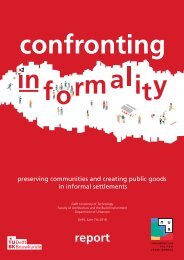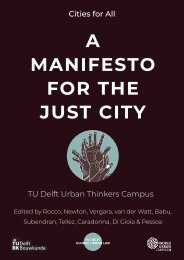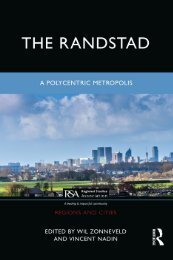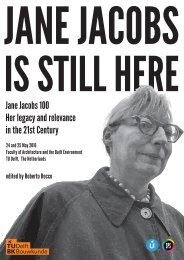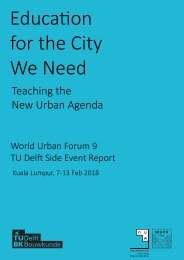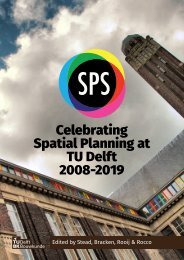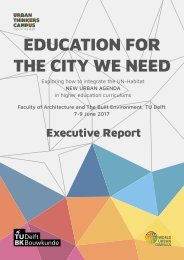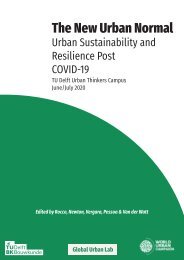The Randstad, a polycentric metropolis, by Vincent Nadin & Will Zonneveld. (Introduction Chapter)
Introduction The Randstad is a cluster of relatively medium-sized and small cities in the western Netherlands that encircles an expanse of largely open land. It is undoubtedly an important urban region, hosting in an area of about 7,000 km2, Europe’s largest seaport, third busiest airport, second largest Internet Exchange, and about 7 million people. But the Randstad is much more than this. Since the 1960s, it has acquired distinction as the archetypal polycentric metropolis, an integrated urban ring around a Green Heart, with the status of a world-class metropolitan region. There is a presumption too, that government has played an inf luential role in strengthening the polycentricity of the region, especially through its renowned capability in spatial planning. But the reality of the polycentric Randstad as opposed to the idea is controversial, as is the role of spatial planning. Do the interconnections between the four main cities – Amsterdam, The Hague, Rotterdam, and Utrecht – and the many smaller settlements in-between function as an integrated polycentric region? Does the economic and social performance of the combined whole of the Randstad add up to more than the sum of its parts? Advocates point to the apparent complementarity of the main cities with a tendency for business and financial functions to be centred in Amsterdam, port and logistics in Rotterdam, governance and international justice in The Hague, and research and development in Utrecht. Critics draw attention to the relatively limited f lows of commuters between the cities, and the concentration of the daily urban f lows within the individual city-regions, which they argue operate independently.
Introduction
The Randstad is a cluster of relatively medium-sized and small cities in the
western Netherlands that encircles an expanse of largely open land. It is undoubtedly
an important urban region, hosting in an area of about 7,000 km2,
Europe’s largest seaport, third busiest airport, second largest Internet Exchange,
and about 7 million people. But the Randstad is much more than
this. Since the 1960s, it has acquired distinction as the archetypal polycentric
metropolis, an integrated urban ring around a Green Heart, with the status of
a world-class metropolitan region. There is a presumption too, that government
has played an inf luential role in strengthening the polycentricity of the
region, especially through its renowned capability in spatial planning.
But the reality of the polycentric Randstad as opposed to the idea is controversial,
as is the role of spatial planning. Do the interconnections between the
four main cities – Amsterdam, The Hague, Rotterdam, and Utrecht – and
the many smaller settlements in-between function as an integrated polycentric
region? Does the economic and social performance of the combined
whole of the Randstad add up to more than the sum of its parts? Advocates
point to the apparent complementarity of the main cities with a tendency for
business and financial functions to be centred in Amsterdam, port and logistics
in Rotterdam, governance and international justice in The Hague, and
research and development in Utrecht. Critics draw attention to the relatively
limited f lows of commuters between the cities, and the concentration of the
daily urban f lows within the individual city-regions, which they argue operate
independently.
You also want an ePaper? Increase the reach of your titles
YUMPU automatically turns print PDFs into web optimized ePapers that Google loves.
Introducing the <strong>Randstad</strong> 19<br />
economic activity in the growth areas of knowledge and creative industries<br />
(Bontje et al., 2011).<br />
<strong>The</strong> gap in government policy towards the wider <strong>Randstad</strong> region was<br />
filled <strong>by</strong> an independent group led <strong>by</strong> urban design and planning professors of<br />
Delft University of Technology and Amsterdam University. <strong>The</strong> group successively<br />
advocated for policy attention to a functionally integrated <strong>polycentric</strong><br />
<strong>metropolis</strong> that could compete with other global regions, specifically at<br />
the level of the whole international delta of north-west Europe beyond the<br />
<strong>Randstad</strong>. This eventually resulted in a strongly articulated policy statement<br />
of the planning aldermen of the four main <strong>Randstad</strong> cities (Deltametropool,<br />
1998). Thus, spatial strategy and interventions at the scale of the ‘Delta<strong>metropolis</strong>’<br />
became a formal part of government policy, taken up in the draft<br />
2001 Fifth Spatial Planning Report (Lambregts and <strong>Zonneveld</strong>, 2004).<br />
Attention to spatial networks in the wider Delta region was short-lived<br />
though as the political colour of government changed which took spatial<br />
policy back towards economic priorities. <strong>The</strong> final 2004 version of the Fifth<br />
Report (authorised translation: National Spatial Strategy) was a corporate<br />
government plan with a strong lead from the Ministry of Economic Affairs,<br />
and for the first time, explicitly recognising the need to deal with the effects<br />
of climate change. <strong>The</strong> <strong>Randstad</strong> returned as the principal location for the<br />
critical drivers of the Dutch economy that would be supported <strong>by</strong> national<br />
government funding: three dominant economic cores (of 13 in the country),<br />
nationally significant development projects or zones including Schiphol Airport<br />
and the port of Rotterdam (both designated as ‘Mainport’), and agricultural<br />
complexes or Greenports.<br />
<strong>The</strong> belated recognition of the need for an integrated strategy also gave<br />
rise to the first, and for now, the last, formal planning document that concentrates<br />
solely on the <strong>Randstad</strong>: Structuurvisie <strong>Randstad</strong> 2040 (Ministerie van<br />
VROM, 2008). <strong>Randstad</strong> 2040 took its lead from the economic agenda of<br />
government and asserted the ambition to strengthen the <strong>Randstad</strong> as one of<br />
Europe’s leading urban regions. It demonstrated the connections between<br />
policies and investments of various government departments and agencies<br />
and set out guiding principles: improving the quality of urban and natural<br />
environments, safety and climate resilience, concentrating new urban development<br />
in the cities, and improving accessibility, especially around the ‘two<br />
centres of gravity’ in the northern and southern <strong>Randstad</strong>.<br />
At the end of the 2000s, it seemed that the <strong>Randstad</strong> idea was restored with<br />
government policy taking on the agenda for a <strong>polycentric</strong> <strong>metropolis</strong> first established<br />
in the 1950s. But <strong>Randstad</strong> 2040 did not anticipate and was quickly<br />
overtaken <strong>by</strong> the severe effects of the 2008 banking crisis. Evers and Vogelij<br />
in <strong>Chapter</strong> 14 explain the weaknesses of the process that gave rise to <strong>Randstad</strong><br />
2040 and its core assumptions, not least that high growth would continue.<br />
<strong>The</strong>y argue that it failed to address political and economic uncertainties and<br />
the lack of wider civil society engagement which fatally undermined the robustness<br />
of its approach. After yet another election the document was shelved.<br />
Taylor & Francis




